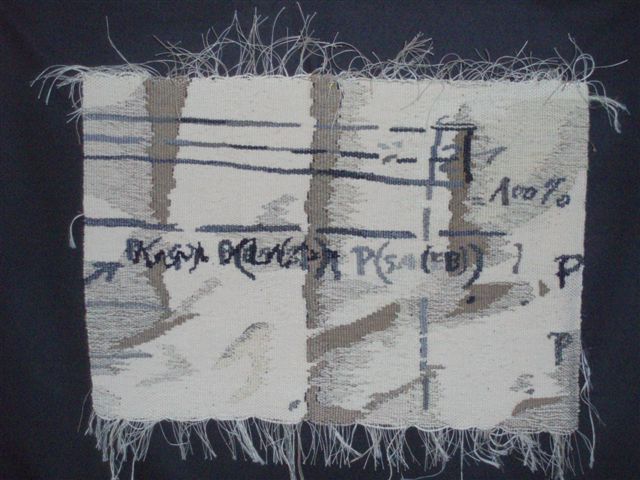Ingrid Wiener: Erste Schritte auf dem Weg zu Bayes # 6
Sunday, April 20th, 2008
Ingrid Wiener: Erste Schritte auf dem Weg zu Bayes # 6, Gobelin 2007, 34×50cm nach Blei- und Filzstiftnotizen auf DIN A4

Ingrid Wiener: Erste Schritte auf dem Weg zu Bayes # 6, Gobelin 2007, 34×50cm nach Blei- und Filzstiftnotizen auf DIN A4
And if mathematics is itself material? Then the world is turned upside-down. If even this most trusted guarantor of necessity and hierarchy turns out to be based on lowly chaotic matter, then what hope is there for an ordered universe? Matter will rule reason, the body will rule the soul, and all hope for salvation, in this world or the next, vanishes. To those who, like the Jesuit fathers, champion an ordered world and a hierarchical social order, in which everything and everyone have their God-given place, nothing could be more sinister than a material mathematics.
The Jesuit Doctors were right: materialist mathematics is dangerous. This is because since the time of Plato mathematics was celebrated precisely for being free of matter, and lording over it. Traditional mathematical arguments begin with simple assumptions and proceed step by step through strict logical deduction to a necessary conclusion. They pay no heed to physical circumstances or human desires, but follow their own inevitable road to unerring results. So conceived, mathematical results are not only True, but also Universal: by studying mathematics we learn necessary truths about the world itself. In this way pure mathematical reasoning rules corrupt and chaotic matter and orders it, just as the reasonable soul rules and orders the corrupt body. To the Jesuit fathers and to others through the centuries, mathematical reasoning stood for the triumph of reason, order, and hierarchy over irrationality, disorder, and egalitarianism.
Atomism was a popular doctrine among 17th century natural philosophers, but it was also a dangerous one. Church theologians condemned atomism as incompatible with the immortality of the soul, the miracle of transubstantiation, and the proper order of knowledge. And because infinitesimal mathematics was essentially mathematical atomism, it too was viewed with suspicion. In 1632 the authorities of the Collegio Romano, world center of Jesuit learning, issued an edict rejecting the method of indivisibles and forbidding its teaching in Jesuit schools. The charge against mathematics? Materialism!
Cavalieri called his system “The Method of Indivisibles,” because it was founded on the premise that continuous lines and surfaces were made up of an infinite number of indivisible points or lines. This was practically identical to material atomism, which argued that material bodies are composed of indestructible atoms. No coincidence there – the word “indivisible” is a direct translation of the Greek “atom.” This means that infinitesimal techniques, a pillar of all of modern mathematics, started their way as the doctrine of mathematical atomism.
Lackmuspapier zur Quart
geklemmte Ziffern schlaf nur
Buch mit Vorhangblei im schmalen
Habichtlicht aus Hundezahl mal
Meterstoff buchstabiertes
Mahnmal minus Mathematik
lagerschwach fackelt das
Aug am ausgestreckten Arm
Geometrical figures are like pieces of cloth. The Italian mathematician Bonaventura Cavalieri (1598-1647) thought so, and invited others to think in this way: “plane figures should be conceived by us as pieces of cloth are made up of parallel threads” he wrote in his Geometria Indivisibilibus of 1635. “And solids are like books, which are composed of parallel pages.”
Cavalieri’s view counted for much, because he was widely credited as a founder of infinitesimal mathematics, which led ultimately to the Calculus. His teacher Galileo believed that infinitesimals were like threads, which woven together make up a rope, and their English contemporary Thomas Harriot (1560-1621) argued that the mathematical continuum is made up of points in the same way that a physical body is composed of atoms. In the 17th century, geometrical bodies were material objects, complex tapestries of interwoven lines, points, surfaces.
Futterlose Geheimgewalt
ringt der abgestandenen
Lastwagenluft Kehle
seilt sich und hebelt
um die sag nur
schwere Kappe
oder Kaminattrappe
ins merklich ungefederte Land
lahmt der Berg darin Felle
schwimmen als Vorsintflut
Mangastrom polare Prinzen
schaben am Krautstock
an der Komabinde
ein Nullmagen lebte zuletzt
schrecklos auf Sonde
klebt
formloser Fuss
verpflichtet, anders zu denken,
dem Griff der Ökonomie, der Verkehrsformen, der Normen der Handelwege und Börsenbetriebe, der Rohstoffsammlung und -vermarktung (Sammelbleche) zu entgehen, indem man anders gewichtet, persönlich wird, wo es nicht verlangt wird, allgemein wird, wo es nicht schicklich ist.
Weltbürgerschaft
verpflichtet, anders zu fühlen: Tod, Explosion, Armut, Gewalt
persönlich aufzufassen, z.B. den Tod der herzkranken Frau in der Moskauer Gurjanowstrasse, die mit der Axt erschlagen wurde, weil sie vermutlich dem russischen Geheimdienst in die Quere kam,
Weltbürgerschaft
verpflichtet, anders zu denken: Tod, Explosion, Armut, Gewalt
allgemein zu nehmen, z.B. die Aufregung, die öffentlich um die Person Marcel Ospel getrieben wird, in ihrer Systematik zu begreifen, anstatt dabei Genugtuung zu empfinden.
Klart mögliche
weder Hefe noch
Wange gefiltert
mutet dass Elbe auf Stroh
auf Hundegelenken
dem Bleiben bis sie
bitter das
Feld nähren Raum
um Schultern sind die unteren
Ohren Sammelbleche
topft
damit wässern sie
Notbeine rudern sie
mit Kraftkäfern
dem Kragen